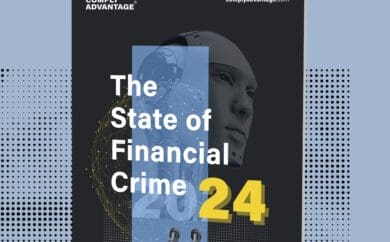As banks and non-bank financial institutions explore new, innovative methods with which to deliver financial services, digital lending has emerged as an opportunity for those organizations to loan money faster and more efficiently. Digital lending is essentially the use of digital platforms to handle the loan process online, from application through to disbursement of money. Driven by advances in technology and government initiatives, the digital loan sector is growing: between 2019 and 2025, the market is expected to reach $11.6 billion, growing at a rate of 20.3% during that period.
However, the increased profile and sophistication of the digital lending market reflects an increased level of risk from criminals. The vulnerabilities of digital lending mean that firms must have effective AML lending processes in place to detect and remediate criminal threats appropriately and ensure that they are not exploited as a way to launder money or finance terrorist activities.
With that in mind, when it comes to AML lending, digital lenders must understand the risks they face and how to comply with the relevant AML/CFT regulations within their jurisdiction.
AML Lending Risks
The money laundering risks to digital lending service providers include those conventional risks inherent in the industry but also reflect the more sophisticated methodologies of criminals that exploit online anonymity and regulatory disparity to evade AML/CFT measures. With that in mind, the key AML lending risks include:
Customer identity: Conventional AML measures in banks and other brick-and-mortar lending businesses allow for the verification of customer identities in person via customer due diligence (CDD) checks. In a digital lending context, however, criminals are better able to conceal their identities when using online services or use proxies to apply for loans on their behalf. Online loan applications with insufficient identity verification may be used to thwart CDD checks and allow criminals to evade other CFT/AML lending safeguards.
Beneficial ownership: Customer due diligence is also important to establishing the beneficial ownership of entities that are applying for loans. Money launderers may seek to further exploit the anonymity associated with digital lending by applying for a loan through a firm that they control, concealing their ownership in order to avoid AML identity verification measures and the scrutiny of authorities.
Cross-border loans: Digital loans can facilitate the speedy transfer of money across borders and jurisdictions. With that in mind, digital lenders may find themselves dealing with customers in different jurisdictions with different regulatory standards for monitoring and reporting transactions. Criminals may be able to use the regulatory disparity between jurisdictions to avoid reporting thresholds for suspicious transactions, or they may seek to take advantage of poor communication and information sharing between international authorities.
Structuring: Digital loan services can take place quickly and in greater frequency than in-person transactions at brick-and-mortar premises. Money launderers may seek to exploit this capability by applying for loans through a variety of digital lenders and carrying out multiple online transactions. Moving money through a variety of digital service providers deepens the appearance of legitimacy and may make it much harder for financial authorities to track the illegal money.
How to Comply with AML Lending Regulations
When it comes to AML, digital lenders must abide by a range of important rules and regulations designed to ensure that they spot suspicious activity and report to the authorities in a timely manner. The Financial Action Task Force (FATF), for example, and its regional bodies require member states to implement its AML recommendations via domestic legislation. In practice, this means that digital lenders and all financial institutions should implement AML lending programs with the following key features:
- Risk-based approach: The FATF requires that firms implement a risk based approach to AML. In practice, digital lenders must put AML/CFT measures in place that reflect their level of risk. Higher-risk customers should be subject to stricter AML measures, while lower-risk customers should be subject to simplified measures.
- Customer due diligence: Digital lenders should ensure that they perform suitable customer due diligence on their customers in order to accurately verify their identities and establish beneficial ownership. Higher-risk customers should be subject to enhanced due diligence (EDD) measures.
- Transaction monitoring: In order to spot potential money laundering, digital lenders must monitor customer transactions for suspicious activity, which may include suspicious transaction patterns or transactions involving high-risk countries.
- Screening: Digital lenders must screen and monitor their customers for politically exposed person (PEP) status, against sanctions lists and for involvement in adverse media stories. PEP-status customers should be considered high-risk and subject to EDD.
In addition to active CDD, monitoring and screening measures, digital lenders should ensure that their AML program includes ongoing training for compliance teams. Additionally, digital lenders should appoint an AML compliance officer with the authority and expertise to oversee their compliance program.
AML lending red flags: Certain “red flags” may indicate that customers of digital lending platforms are involved in money laundering. These red flags include:
- Transactions above reporting thresholds.
- Suspicious transactions patterns or transactions with high-risk countries.
- Customers making multiple online loan transactions in a manner that indicates structuring.
- Customers attempting to conceal their identity in online loan applications.
- Frequent overpayment of loan repayments.
- Transactions involving sanctioned customers, PEPs or customers that are the subject of adverse media.
AML Software for Digital Lenders
In order to satisfy AML/CFT compliance obligations and continue to provide the level of efficient service that customers expect, digital lenders should implement a suitable AML software platform to handle their regulatory needs. Automating AML via software is a way for digital lenders to manage their data collection and analysis obligations, delivering speed and efficiency during the compliance process and reducing human error. AML software also enables digital lending firms to better deliver ongoing compliance by adapting more quickly to changes in legislation and emergent criminal methodologies.
Originally published 13 July 2020, updated 29 January 2024
Disclaimer: This is for general information only. The information presented does not constitute legal advice. ComplyAdvantage accepts no responsibility for any information contained herein and disclaims and excludes any liability in respect of the contents or for action taken based on this information.
Copyright © 2024 IVXS UK Limited (trading as ComplyAdvantage).



 EN
EN